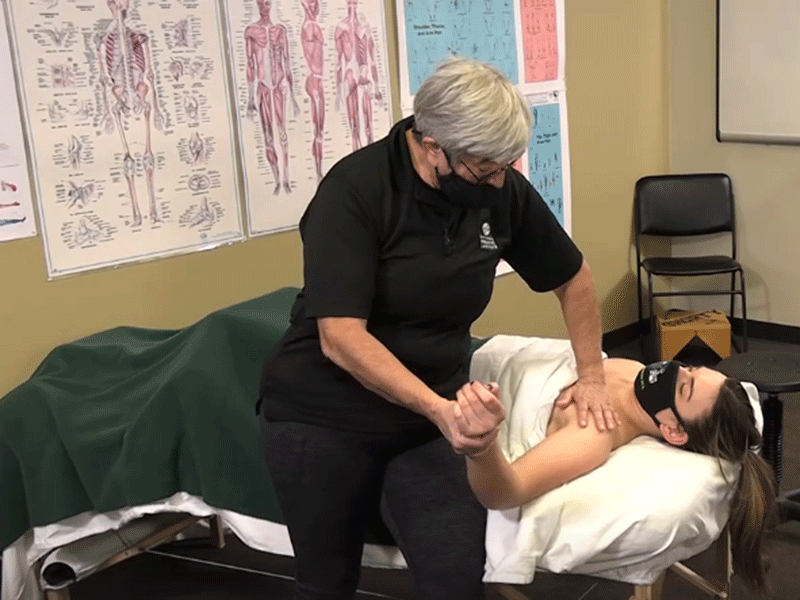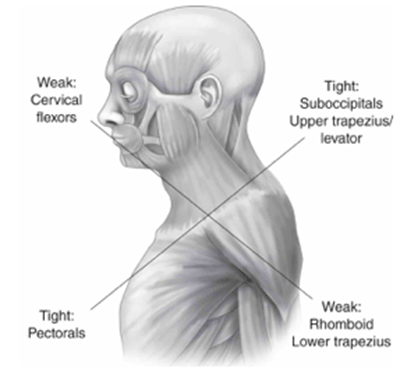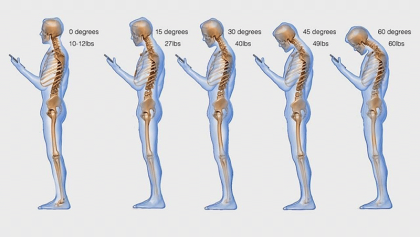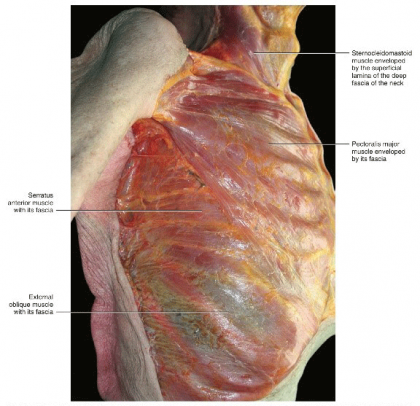“Text Neck” and Why Neuromuscular Therapists Spend More Time on the Front of the Body for Back, Neck, and Shoulder Pain

ANMT Program founder Cynthia Ribeiro providing neuromuscular therapy for back, neck and shoulder pain.
Typically, when patients come to an appointment complaining of back, neck, and shoulder pain we will notice very specific similarities in soft tissue and posture. Invariably, Massage Therapists will start their patient prone and start digging elbows into the middle of the back to address the pain. Unfortunately, this can do more harm than good because we’re potentially dealing with a condition some may refer to this as “Silicon Valley Syndrome” or “Text Neck;” for our purposes, we will use the clinical term “Upper Cross Syndrome” or UCS.

Figure 4.2 (a)1
Upper Cross Syndrome (UCS), “tightness of the upper trapezius and levator scapula on the dorsal side crosses with tightness of the pectoralis major and minor. Weakness of the deep cervical flexors ventrally crosses with weakness of the middle and lower trapezius.”1 Because the discomfort is typically felt in the posterior aspect of the body; most Massage Therapists will spend the majority of the session with the patient prone.
This is a mistake. The work that is being done is lengthening the muscles that are already lengthened which then provide a mechanical advantage to the muscles in the anterior portion of the body which will allow them to contract more with less posterior resistance. An interesting point of consideration is that while we need to pay attention to the musculature, it isn’t the muscles alone that can be affected by UCS.
The Muscles
Vladimir Janda indicated two main perspectives regarding muscles imbalance; the Biomechanical Paradigm considers “…constant stress that muscles experience due to prolonged postures and repetitive movements.”2 The Neurological Paradigm “…recognizes that muscles are predisposed to become imbalanced because of their role in motor function. The neural control unit may alter the muscle recruitment strategy to stabilize joints temporarily in dysfunction. This change in recruitment alters muscle balance, movement patterns, and ultimately the motor program.”2

Postural affects of “Text Neck”
As stated, the shortened muscles are the pectoralis major, pectoralis minor, upper trapezius, and the levator scapula. These muscles, according to Janda, are affected by the Neurological Paradigm; “…muscles prone to tightness are one third stronger than muscles prone to inhibition…(T)ightness of a muscle reflexively inhibits its antagonist, creating muscle imbalance. This muscle imbalance leads to joint dysfunction because of unbalanced forces. Joint dysfunction creates poor movement patterns and compensations, leading to early fatigue. Finally, overstress of activated muscles and poor stabilization leads to injury.”3
While the first illustration indicates posterior and anterior muscle weakness, it may be more appropriate to use the term inhibited or hypotonic. This is because the term weakness can be associated with muscles that are hypertonic and hypotonic. With the muscles that are hypertonic can be considered weak because “(O)verused muscle shortens over time, changing the muscle’s length-tension curve and becoming more readily activated and weaker over time.
There is also an increase in the noncontractile tissue and a decrease in elasticity, leading to hypertrophy.”4 The hypotonic muscle or stretch weakness “is a condition in which a muscle is elongated beyond physiological neutral but not beyond the normal ROM. Prolonged muscle elongation causes muscle spindle inhibition and the creation of additional sarcomeres…Stretch weakness is also known as positional weakness and is often associated with overuse and postural changes.”5
This reflexive inhibition of the antagonist becomes a major issue if we continue to focus session time on those muscles that are inhibited. Those muscles include the anterior cervical flexors, rhomboids, and lower trapezius muscles where most Therapists will focus the session; specifically, the rhomboids and lower trapezius.
Neurological Re-Education
The attention to both groups of muscles goes a little bit deeper than which group to address. Stretching and lengthening the hypertonic muscles and strengthening the hypotonic muscles isn’t enough; additional steps are necessary to begin creating lasting change. In order to truly provide effective rehabilitation, three things need to occur:
- Normalization of the peripheral structures. All peripheral structures outside the CNS must be treated in order to improve the quality of afferent information being received by the CNS.
- Restoration of muscle balance. The balance between the phasic and tonic muscle systems must be improved as a prerequisite for improving coordination.
- Facilitation of afferent system and sensory motor training. This training improves movement coordination and therefore promotes ideal mechanical loading of biological structures and efficient motor execution.7
As we consider the peripheral structures, we will notice postural changes that occur with UCS; from superior to inferior, a “forward head posture, increased cervical lordosis and thoracic kyphosis, elevated and protracted shoulders, and rotation or abduction and winging of the scapulae.”6 The need to balance the musculature that is responsible for the stability of the glenohumeral joint and the Scapulothoracic junction must be address prior to neurological retraining otherwise we’re just strengthening inappropriate postural and motor patterns which perpetuate the cycle of pain and dysfunction.
There’s One More Thing…

Figure 5.18 Anteriolateral view of the trunk. The serratus anterior muscle is deeper with respect to the pectoralis major muscle. The pectoral fascia passes over the serratus anterior to envelope the latissimus dorsi muscle.8
Okay…it’s going to happen…brace yourselves…this ‘F’ word is going to appear…FASCIA! With the knowledge that fascia runs through every aspect of our body we have to remember that it is deeply affected by the muscular tissue. The simplified chain reaction would look something like this:
- Fascia of the pectoralis major shortens in relation to the musculature.
- The fascia is then connected to the abdominal fascia which also shortens in relation to the abdominal muscles.
- The increased anterior tension in the fascia pulls on the chain that goes around the shoulder and above the shoulder to encase the serratus anterior, the superior aspect of the upper trapezius, and the sternocleidomastoid.
- In the thoracic and lumbar region; the tension travels posteriorly to increase the length of the thoracolumbar aponeurosis which then pulls on the latissimus dorsi and the gluteals.
This very brief synopsis shows in integral relationship between the muscles and the fascia; it is actually much more complicated and involves additional structures; trust me when I say it truly is all connected.
Summary
While addressing our client’s needs in regards to upper back, neck, and shoulder pain, Upper Cross Syndrome is one of the most likely culprits. In order to properly address UCS, it is important to manage the hypertonic musculature which lies mostly anterior and is very easily accessible from a supine and side-lying position.
After addressing the hypertonic musculature, be sure to interact with the hypotonic musculature and please don’t forget the fascia. Neurological retraining needs to occur in order to create a lasting affect which means the patient’s activities of daily living that may be contributing to UCS need to be identified and remedied.
1Assessment and Treatment of Muscle Imbalance: The Janda Approach p.52, C Frank, R Lardner – 2011
2Assessment and Treatment of Muscle Imbalance: The Janda Approach p.7, C Frank, R Lardner – 2011
3Assessment and Treatment of Muscle Imbalance: The Janda Approach p.50, C Frank, R Lardner – 2011
4Assessment and Treatment of Muscle Imbalance: The Janda Approach p.51-52, C Frank, R Lardner – 2011
5Assessment and treatment of Muscle Imbalance: The Janda Approach p.50, C. Frank, R Lardner – 2011
6Assessment and treatment of Muscle Imbalance: The Janda Approach p.53, C. Frank, R Lardner – 2011
7Assessment and treatment of Muscle Imbalance: The Janda Approach p.124-125, C. Frank, R Lardner – 2011
8Functional Atlas of the Human Fascial System p.161, C. Stecco – 2015
Get all the details about NHI’s Advanced Neuromuscular Therapy Program now. Complete this form to connect with an Admissions Representative.